Summary | Excerpt | Reviews | Beyond the book | Read-Alikes | Genres & Themes | Author Bio

Science, Politics, and the Human Costs of Defeating Disease
by Meredith WadmanThe history of modern vaccine invention and development is a testament to the selfless work and dedication of individuals passionate about science and medicine, but it is also fraught with ethical dilemmas, academic rivalries and political skulduggery.
This is the point that renowned science journalist Meredith Wadman makes in The Vaccine Race, her riveting book that details how, over the course of seventy years, human cells came to be used to combat killer diseases. The main thread of the story is the development of the vaccine against the rubella virus that causes German measles. In pregnant women, this otherwise mild infection can cause improper development of the foetus's heart, brain and eyes. The efforts to halt an impending rubella epidemic in the U.S. in the 1960s forever changed how vaccines are made.
Two scientists in particular were at the heart of these developments: Stanley Plotkin and Leonard Hayflick, without whom vaccines today would likely not be as effective.
Hayflick and Plotkin had similar humble beginnings, Hayflick in a working class family in Philadelphia, Plotkin in New York. Both were studious boys keenly interested in science; both benefited from grants to study. Hayflick went to the University of Pennsylvania, Plotkin to Downstate College of Medicine in Brooklyn. Their paths crossed when they began working at the Wistar Institute in Philadelphia, the first independent institution in the U.S. devoted to medical research and training, but their career trajectories could not have been more different.
Hayflick was curious, persistent, and not averse to challenging convention. He was fascinated by the idea that cells could age just as organisms do. He discovered that cells die after a certain number of divisions, a phenomenon now termed the Hayflick limit. He developed cell cultures from foetal lung tissue, and grew these into lines, consisting of cells with a uniform genetic makeup. He named one of these the WI-38 line (the letters for Wistar Institute, and the number because the cells had divided 38 times.) Other scientists at the institute would use these cells for their experiments.
Plotkin was one such scientist. As a doctor, he had witnessed first-hand the pain and suffering caused by a rubella epidemic in London in 1962 and was determined to fight this disease. He and his colleagues worked together to isolate the cause of the infection and develop a vaccine. After many attempts at growing the virus in WI-38 cells, he created an effective treatment. At the time, however, the U.S. vaccine regulatory body supported vaccines made from monkey cells because that was what they had been used to. This body's resistance to change caused the human cell-derived vaccine to be sidelined. It was not until the late 1970s, when Plotkin's work outside the U.S. demonstrated the superiority of his vaccine in terms of efficacy and safety, that the U.S. National Institutes of Health accepted that vaccines derived from human cell lines were far better than those developed from animal cells.
By this time, the potential economics of vaccines and science were beginning to be appreciated. Scientists who had for decades worked for the sake of knowledge, were becoming millionaires by selling their patents and expertise to multinational companies who could commercialize products. Hayflick resented that some of these individuals were benefiting on the back of his work on the WI-38 cell line. When he moved to Stanford University's School of Medicine in 1968 to take up the Professorship of Medical Microbiology, he took his WI-38 cells with him, contravening his contract with Wistar and the government. As a result, he was investigated and subsequently ostracized by the scientific community. It was only in the 1980s that Hayflick's reputation was restored and he was able to make significant contributions to research again, particularly in the field of ageing.
Wadman's journalistic experience is evident. She has written for Science, Nature, The New York Times and The Washington Post for years. In The Vaccine Race, Wadman expertly corrals the hordes of details, and packages them in a way that is not only understandable but also allows us to appreciate the political context that resulted in particular decisions and outcomes. Thus, while we abhor the testing of vaccines on unconsenting orphans, prisoners and intellectually disadvantaged people, we can appreciate that this was before the days of Research Ethics Committees. Nowadays we take these committees for granted, to safeguard the safety, dignity and well-being of research participants, independently of research sponsors, but they did not emerge until well into the 1980s.
At a time when the Zika virus threatens the emerging generation in the same way that rubella did decades ago, Wadman's book gives us important insights into how science can be fostered or impeded by the establishment. As she quotes vaccine researcher Alan Shaw: "Developing vaccines is one of the most productive things you can do, simply because if you succeed in getting one made, you watch a disease disappear."
Of course, for this to happen, people must take the vaccine. Although numerous studies have demonstrated no link between vaccination and autism, some people remain concerned and refuse vaccinations both for themselves and their children. This, in part, has caused the reemergence of diseases such as pertussis (whooping cough) and measles. Since The Vaccine Race documents the history of vaccine development until the 1980s, the author doesn't address the more recent controversy over vaccines and autism, except to note that in 7% of children with congenital rubella—whose mothers were not vaccinated against the disease—brain damage causes autism. I'm hoping Wadman will continue to write about vaccines and document the advances and controversies of the last thirty years, to help complete our picture of this critical aspect of public health.
![]() This review was originally published in The BookBrowse Review in April 2017, and has been updated for the
September 2018 edition.
Click here to go to this issue.
This review was originally published in The BookBrowse Review in April 2017, and has been updated for the
September 2018 edition.
Click here to go to this issue.

If you liked The Vaccine Race, try these:

by Lindsey Fitzharris
Published 2023
Lindsey Fitzharris, the award-winning author of The Butchering Art, presents the compelling, true story of a visionary surgeon who rebuilt the faces of the First World War's injured heroes, and in the process ushered in the modern era of plastic surgery.

by Walter Isaacson
Published 2022
Winner of the 2021 BookBrowse Nonfiction Award
The bestselling author of Leonardo da Vinci and Steve Jobs returns with a gripping account of how Nobel Prize winner Jennifer Doudna and her colleagues launched a revolution that will allow us to cure diseases, fend off viruses, and have healthier babies.
Your guide toexceptional books
BookBrowse seeks out and recommends the best in contemporary fiction and nonfiction—books that not only engage and entertain but also deepen our understanding of ourselves and the world around us.